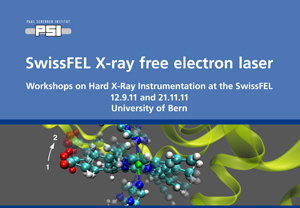Speaker
Jan Steinbrener
(Max-Planck-Institut fuer medizinische Forschung)
Description
The elucidation of structures of macromolecules is an important step in the quest of understanding the chemical mechanisms underlying biological function. X-ray crystallography is a mature method that is only limited by the quality of the crystals investigated and by radiation damage. Intense, femtosecond X-ray pulses provided by X-ray free-electron lasers promise to break the nexus between radiation damage and crystal size, thereby allowing structure determination using nano- and microcrystals. Recent serial femtosecond crystallography (SFX) experiments at the LCLS have shown the feasibility of this approach [1]. A continuous liquid microjet was used to inject randomly oriented crystals with a flow rate of ~ 10 microl/min into the FEL beam [2,3]. The diffraction patterns were collected in vacuum at the repetition rate of the FEL in the CAMP [4] or CXI instruments [5] using pnCCD or CSPAD detectors, respectively. Due to the mismatch between continuous sample flow and stroboscopic data collection, sample consumption is huge. FEL-triggered drop-on-demand approaches have been proposed and are being explored [3]. For very precious samples, other possibilities need to be explored which include preparation on fixed targets and cryo-stages, which are ideally integrated into dedicated endstations with appropriate detectors. Since the crystals intersect the FEL beam very fleetingly, only thin slices through the rocking curve are recorded, requiring many measurements of the reflections to allow a Monte-Carlo like integration of the beam profiles [6,7]. A pink or Laue beam has not only more flux than a monochromatic beam but is also more efficient in sampling reciprocal space. A shot-to-shot analysis of the spectrum would be highly desirable, for example to allow accurate profile fitting including coherent diffraction features as would be the availability of a divergent beam that can be matched to the sample size.
1. Chapman, H. N. et al. Femtosecond X-ray protein nanocrystallography. Nature 470, 73-77 (2011).
2. DePonte, D. P. et al. Gas dynamic virtual nozzle for generation of microscopic droplet streams. J. Phys. D: Appl. Phys. 41, 195505 (2008).
3. Weierstall, U., Doak, R.B., Spence, J.C.H. A pump-probe XFEL particle injector for hydrated samples. arXiv:1105.2104v1 [physics.ins-det] (2011)
4. Strueder, L. et al. Large-format, high-speed, X-ray pnCCDs combined with electron and ion imaging spectrometers in a multipurpose chamber for experiments at 4th generation light sources. Nuclear Instruments and Methods in Physics Research A 614, 483-496 (2010).
5. Boutet, S. and Williams G. J. The Coherent X-ray Imaging (CXI) instrument at the Linac Coherent Light Source (LCLS) New Journal of Physics 12, 035024 (2010)
6. Kirian, R. A. Femtosecond protein nanocrystallography-data analysis methods. Optics Express 18, 5713-5723 (2010).
7. Kirian, R. A. et al. Structure-factor analysis of femtosecond microdiffraction patterns from protein nanocrystals Acta Crystallogr. A 67, 131-140 (2011)
Author
Jan Steinbrener
(Max-Planck-Institut fuer medizinische Forschung)
Co-authors
Aliakbar Jafarpour
(Max-Planck-Institut fuer medizinische Forschung)
Artem Rudenko
(Max-Planck-Institut fuer Kernphysik)
Daniel Rolles
(Max-Planck-Institut fuer medizinische Forschung)
Faton Krasniqi
(Max-Planck-Institut fuer medizinische Forschung)
Ilme Schlichting
(Max-Planck-Institut fuer medizinische Forschung)
Joachim Ullrich
(Max-Planck-Institut fuer Kernphysik)
Lothar Strueder
(Max-Planck-Institut Halbleiterlabor)
Lukas Lomb
(Max-Planck-Institut fuer medizinische Forschung)
Lutz Foucar
(Max-Planck-Institut fuer medizinische Forschung)
Robert Hartmann
(PNSensor GmbH)
Robert L. Shoeman
(Max-Planck-Institut fuer medizinische Forschung)
Sadia Bari
(Max-Planck-Institut fuer Kernphysik)
Sascha Epp
(Max-Planck-Institut fuer Kernphysik)
Stephan Kassemeyer
(Max-Planck-Institut fuer medizinische Forschung)
Thomas R.M. Barends
(Max-Planck-Institut fuer medizinische Forschung)

